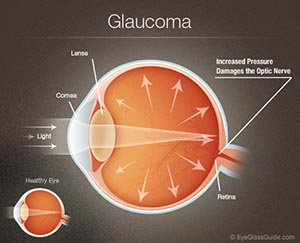Glaucoma is a disease in which the optic nerve is damaged, leading to progressive, irreversible loss of vision. It is often, but not always, associated with increased pressure of the fluid in the eye.
The nerve damage involves loss of retinal ganglion cells in a characteristic pattern.these changes can be recorded with visual field analysis by AUTOMATED PERIMETER and optic nerve evalution by OCT scan.
 The early diagnosis and treatment is the key to prevent visula loss from this dreaded eye disease.
The early diagnosis and treatment is the key to prevent visula loss from this dreaded eye disease. Raised intraocular pressure is a significant risk factor for developing glaucoma (above 22 mmHg or 2.9 kPa). One person may develop nerve damage at a relatively low pressure, which is termed as LOW TENTION GLAUCOMA while another person may have high eye pressure for years and yet never develop damage this is called as OCULAR HYPER TENTION . Untreated glaucoma leads to permanent damage of the optic nerve and resultant visual field loss, which can progress to PERMANENT BLINDNESS.
Glaucoma can be divided roughly into two main categories, “OPEN ANGLEOR CHRONIC SIMPLE GLAUCOMA” and “CLOSESED OR NERROW ANGLE GLAUCOMA” .
Open angle, chronic simple glaucoma tends to progress more slowly and the patient may not notice that they have lost vision until the disease has progressed significantly.This is often termed as silet killer .It is diagnosed on routine examination .this can be treated with medication which has to be continued life long unless operated called as TRABECULECTOMY.
Closed angle glaucoma can appear suddenly and is often painful; visual loss can progress quickly but the discomfort often leads patients to seek medical attention before permanent damage occurs.This loss or attack can be easily avided by a simple laser procedure called as YAG IRIDOTOMY.The permanent treatment is usually by surgery called TRABECULECTOMY.